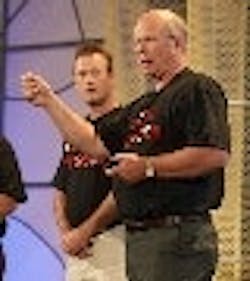Creative thinking streamlines cut-over at Frontier refinery
From the Editors of CONTROL
Given recent demand—and margins!—in the refining industry, shutting down the crude unit was unacceptable, and the migration team had to find a way to seamlessly transfer the control infrastructure to the new architecture, with nary a glitch in ongoing operations.
Here in Phoenix at the annual gathering of the Honeywell User Group Americas, Leland Borgett, Jeff Strecker and Tom Clark took the stage to explain how their five-person team successfully performed their “covert cut-over,” so named for its minimal impact on ongoing operations. Their appropriately labeled T-shirts even tied into the conference theme, with “I create the solution”, “I implement the solution”, and “I maintain the solution”, appropriately emblazoned on each of their chests.
After reviewing a brief history of technology cut-overs experienced at the plant—from pneumatics and electronics to distributed control, Borgett explained that this was their first DCS to DCS cut-over. Traditionally, cut-over had involving bypassing the valve in question and returning it to service as quickly as possible so as not upset the process. This approach is difficult and time-consuming at best, he said, and this time around the team found that some of the valves didn’t even have bypasses installed. Further, while they planned to perform the cut-over at the field junction boxes, tag names on the LCN couldn’t be duplicated in parallel on the new system, so some creative thinking was in clearly in order.
To overcome this issue, the team came up with a unique strategy that employed a field calibrator rigged to simulate the current output of the older control system. The calibrators output was matched to current output of the control system, and, after notifying the control room that they were taking over, it was “cut and flip” over to calibrator control. (Can you say “control in the field?”) Meanwhile, with the valve controlled from the field calibrator, the point was deleted from the older control system and reinstantiated in the new.
"We then matched the new controller’s output to that of the calibrator,” Strecker explained, “and simultaneously closely the knife switch in the new marshalling cabinet and toggled off the field calibrator.” Control room operators were then back in control—transparently, from their point of view.
“We moved 760 I/O points in 25 days,” Borgett said. “All with no upsets, no overtime, no loss of production and no valves bypassed. Remarkably enough, we even set some new production records in the process.”


